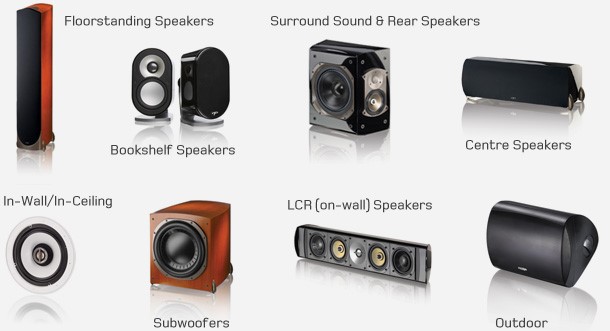In this article, the first step is understanding speaker specifications and explain the most important tips you need to look into when researching speakers.
Speaker enclosure
A speaker unit does not exist without its enclosure. The enclosure can be a dedicated wooden or plastic box in the case of free standing speakers, or the cavity created between a drywall and a concrete wall in the case of in-wall speakers.

The size of a speaker enclosure should be related to the room size. A speaker designed for a much bigger room will not sound good in a smaller room. The size of the speaker enclosure determines the volume of air movement, and therefore the sound energy that such a speaker system can create in a room.
Speaker enclosures come in various forms such as bass reflex or ported enclosures that have a hole in the front or back to leak more bass into the room. Well-designed sealed enclosures tend to produce more accurate sound.
[Speaker enclosure]
Well-made speaker enclosures use a reinforced structure referred to as a braced enclosure to ensure that the enclosure vibrate as little as possible. Enclosure vibration adds undesirable coloration to sound especially at the resonant frequency of the enclosure; this tends to be closer to the upper bass frequencies.
Diaphragm material
The driver diaphragm is fixed to the metal basket via a flexible surround at one end and a spider at the other. The whole diaphragm/voice coil is free to move in accordance with the movement created by the voice coil in response to the electric signal.
[Diaphragm]
Faster high quality drivers diaphragm use either aluminum or titanium; these are mainly employed in high-end tweeters. However, cheaper materials such as reformed silk, paper and certain plastics also produce excellent sound.
[Type of Diaphragm]
Power rating
This is often defined in nominal power (Watts RMS).
Speaker impedance
Impedance represents the resistance a speaker offers to the electrical signal; the lower the impedance, the more power (current) a speaker will draw from the amplifier for a given output voltage.
This means a 4-Ohm speaker will load more an amplifier for the same output signal level than an 8-Ohm one. So do not just buy speakers without taking into account your AV receiver or amplifier specifications.
Sensitivity
One of the most critical speaker specifications is speaker sensitivity. This is specified in dB (decibels), using a one-watt test tone measured one meter away from the speaker.
This means sensitivity affects how much power your system needs to perform well within your set-up. Average speaker sensitive stands at around 87 to 88 dB. Note that this measure is logarithmic, meaning a 3dB reduction in speaker sensitivity requires doubling of the amplifier power to produce the same sound volume in the room.
[Speaker Sensitivy]
Speaker frequency response
In view that speaker frequency response is not constant over the entire range, response is often specified within a variance limit – typically ±3dB . This ±3dB represents reasonable consistency; some manufactures also specify an extended frequency response at ±6dB but this in itself is meaningless as it would require up to four times the amplifier power for the lows in the speaker response to sound as loud as the highs within the range.
A speaker having a specified frequency response ranging from say 40Hz to 22kHz ±3dB can be considered to have pretty good coverage ranging from good bass to a high frequency that is just in excess of the average human hearing upper limit.
Speaker dispersion
Speaker dispersion (H x V) specifies the speaker sound radiation pattern along different angles. It tells you how sound varies as one moves away from the speaker main axis. If you look at the specifications of speaker boxes, you should see nominal angle of high frequency dispersion in the horizontal and vertical plane.
[Speaker dispersion]
Magnetically shielded speakers
The permanent magnets used in speakers are extremely strong magnets that may interfere with the TV electromagnetic field used to deflect the electron beam; the result is a distorted TV or Home Theater System image or when speakers are placed at close distance to the screen. Speakers intended for that purpose should use magnetic shielding.
[Magnetically shielded speakers]

